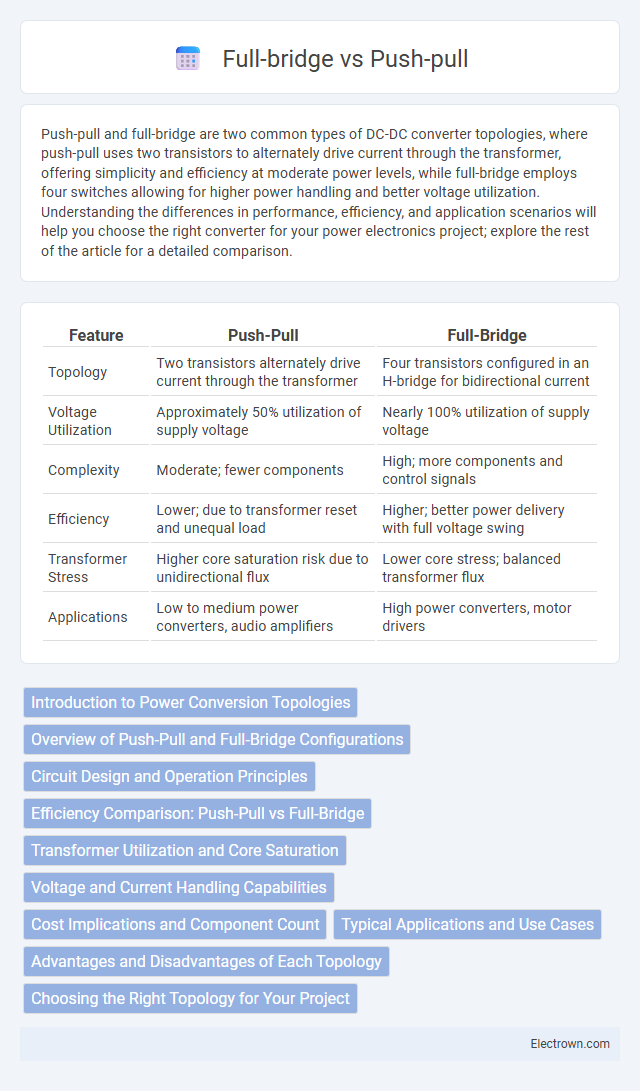Push-pull and full-bridge are two common types of DC-DC converter topologies, where push-pull uses two transistors to alternately drive current through the transformer, offering simplicity and efficiency at moderate power levels, while full-bridge employs four switches allowing for higher power handling and better voltage utilization. Understanding the differences in performance, efficiency, and application scenarios will help you choose the right converter for your power electronics project; explore the rest of the article for a detailed comparison.
Table of Comparison
| Feature | Push-Pull | Full-Bridge |
|---|---|---|
| Topology | Two transistors alternately drive current through the transformer | Four transistors configured in an H-bridge for bidirectional current |
| Voltage Utilization | Approximately 50% utilization of supply voltage | Nearly 100% utilization of supply voltage |
| Complexity | Moderate; fewer components | High; more components and control signals |
| Efficiency | Lower; due to transformer reset and unequal load | Higher; better power delivery with full voltage swing |
| Transformer Stress | Higher core saturation risk due to unidirectional flux | Lower core stress; balanced transformer flux |
| Applications | Low to medium power converters, audio amplifiers | High power converters, motor drivers |
Introduction to Power Conversion Topologies
Push-pull and full-bridge topologies are fundamental power conversion circuits used in DC-DC converters and inverters, each offering distinct advantages in efficiency and complexity. Push-pull converters utilize a center-tapped transformer to alternately drive current through the load, enabling simple design but limited voltage handling capabilities. Full-bridge converters employ four switches arranged in an H-bridge configuration, providing higher power output and improved voltage conversion efficiency suitable for high-power applications.
Overview of Push-Pull and Full-Bridge Configurations
Push-pull and full-bridge configurations are common topologies in DC-DC converters and inverters, offering efficient power conversion and voltage regulation. The push-pull design uses two transistors that alternately drive the transformer primary, providing a center-tap connection and simplifying transformer winding, which is effective for moderate power applications. Full-bridge topology employs four switching devices arranged in an H-bridge, enabling full utilization of the transformer primary with higher power capacity and better output voltage control for demanding electrical loads.
Circuit Design and Operation Principles
Push-pull circuit design features two transistors that alternately conduct, driving the transformer with opposite polarity and improving efficiency by minimizing switching losses. Full-bridge topology consists of four transistors arranged in an H-bridge configuration, allowing the load voltage to be reversed and enabling higher power output with precise control. Your choice between these circuits depends on factors such as power requirements, complexity, and application-specific performance needs.
Efficiency Comparison: Push-Pull vs Full-Bridge
Push-pull converters typically offer high efficiency in low to medium power applications due to their simpler design and lower conduction losses. Full-bridge converters provide superior efficiency at higher power levels by minimizing voltage stress on components and enabling better transformer utilization. Efficiency differences between push-pull and full-bridge topologies are influenced by switching frequency, load conditions, and component selection.
Transformer Utilization and Core Saturation
Push-pull converters utilize the transformer more efficiently by magnetizing the core in alternating polarity, which reduces core saturation and allows continuous energy transfer during both halves of the switching cycle. Full-bridge converters, while offering better power handling by using all four switches to drive the transformer in both directions, face increased risk of core saturation if not carefully designed due to potential unbalanced volt-seconds. Proper transformer utilization in full-bridge topologies requires precise control of timing and driver signals to prevent saturation, whereas push-pull designs inherently balance volt-seconds across the core.
Voltage and Current Handling Capabilities
Push-pull converters typically handle moderate voltage and current levels by alternating the current flow through a center-tapped transformer, allowing efficient energy transfer with reduced stress on individual components. Full-bridge converters provide higher voltage and current handling capabilities by using four switching devices to control power delivery across the entire transformer winding, making them ideal for high-power applications. Your choice between push-pull and full-bridge topologies depends on the specific voltage and current requirements of your power conversion system.
Cost Implications and Component Count
Push-pull converters generally offer lower cost implications and a reduced component count compared to full-bridge converters, making them more economical for lower power applications. Full-bridge converters require four switches and additional drivers, increasing complexity, cost, and component count, which can add to the overall manufacturing and maintenance expenses. Your choice between these topologies should consider the trade-off between the budget constraints and performance requirements of your power supply design.
Typical Applications and Use Cases
Push-pull converters excel in low- to medium-power applications such as DC-DC conversion in power supplies for telecommunications, battery chargers, and moderate power motor drives due to their simplicity and cost-effectiveness. Full-bridge converters are preferred in high-power scenarios including industrial motor control, renewable energy inverters, and electric vehicle powertrains because they provide higher efficiency, better voltage utilization, and improved output power handling. Both topologies are critical in power electronics, with push-pull suited for compact, efficient designs and full-bridge enabling robust, high-power applications.
Advantages and Disadvantages of Each Topology
Push-pull converters offer simplicity and cost-effectiveness with fewer components, resulting in easier control and lower electromagnetic interference, but they suffer from lower efficiency and potential core saturation due to the transformer being driven in both directions. Full-bridge topologies provide higher efficiency and better power handling capability by using four switches for full transformer utilization, minimizing voltage stress on components, though they are more complex and expensive due to increased switch count and gate drive requirements. Your choice depends on the specific application needs such as power level, efficiency priorities, and budget constraints.
Choosing the Right Topology for Your Project
Choosing between push-pull and full-bridge topologies depends on your project's power efficiency and complexity requirements. Push-pull topology offers simpler design and lower component count, making it ideal for medium power applications with moderate cost constraints. Full-bridge provides higher efficiency and better transformer utilization, suitable for high power levels and applications demanding precise control and minimal harmonic distortion.
Push-pull vs Full-bridge Infographic

 electrown.com
electrown.com